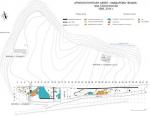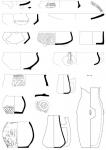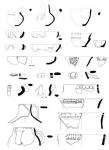Summary (English)
ARCHAEOLOGICAL EXPLORATIONS NEAR SIMEONOVGRAD (Yavor Boyadziev – yavordb@abv.bg, Antoaneta Andonova, Kamen Boyadziev) The site was situated to the south above the ancient bed of the River of Maritsa. Early Neolithic sherds and an anthropomorphic figurine were found, related to the settlement located nearby. During the first phase of the Late Neolithic period (Karanovo III) a scattered settlement existed on the site. Three complexes were explored, each one consisting of one – two houses. Floor plasters, parts of walls, ovens and loom weights were discovered. One building most probably was two-storey. Over 100 storage pits were discovered in the area between the houses. The settlement had at least two occupation phases. The finds included sherds, over 150 fragments from small terracotta cult tables, anthropomorphic and zoomorphic figurines, terracotta models of grain, stone and flint and bone tools, and a shell of a sea urchin painted in Akropotamos Style, indicating relations with the Aegean coast. Early Chalcolithic sherds were found and five Late Chalcolithic pits were explored. Two Early Bronze Age occupation layers were discovered and groups of hearths were explored, some of them located under shelters. The finds included Early Bronze Age I and III sherds, stone and bone tools, fragments from stone battle axes, a terracotta model of a wheel and a terracotta anthropomorphic figurine. Sherds from the Middle Bronze Age or the beginning of the Late Bronze Age were also found on the site. In addition, Thracian sherds from the Classical and Hellenistic periods were discovered. Two piles of sherds of the 2nd – 4th centuries AD were explored, including from dolia with stone lids. Sherds of the 9th – 10th centuries and of the 12th – 14th centuries were also found on the site.
- Yavor Boyadziev - Archaeological Institute with Museum
- Antoaneta Andonova - Department of Archaeology, Sofia University St. Kliment Ohridski
- Kamen Boyadziev - Archaeological Institute with Museum
Director
Team
Research Body
- Archaeological Institute with Museum






![Download [PDF]](/excavation/skins/fasti/images/results/download_sml.png)

